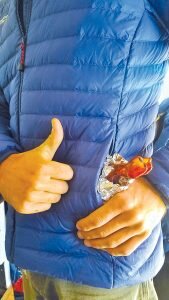
The smoke near Winthrop was unbearable and the fire rained ash on our vehicles overnight; we swept it off the windshield just to be able to see clearly. Our fire crew dealt with this constantly while trying to make loads of overtime pay to squirrel away for off-season adventures.
On a lunch break during a particularly grueling 16-hour day, during which we burned off miles of fire line, I sat crouched over my Meal Ready to Eat (MRE) dreading whatever mock flavor I would scarf down. I searched through the package and threw my cheese spread, canned meat, and off-brand energy bar to my friend Andrew, leaving me with packaged chili. He put them in a plastic bag that was already brimming with similar items and said something along the lines of, “Yeah dude, thanks!”
He was prepping. Not for the end of the world, but for ski season on a dirt-bag budget. I chuckled at the thought of freezing car bivies in the Heather Meadows parking lot paired with canned meat breakfasts and began dreaming of the snow that would snuff the fires into history. The endless turns of my ski dreams were fueled with a diverse, lightweight and high-energy meal-plan that does not depend on hoarded MREs, while also not breaking the bank.
Andrew is not alone. Though most people don’t stash away MREs to eat all winter while ski touring, many simply throw a handful of bars into their pack and roll out the door – a lightweight approach that’s only marginally better than canned meat and cheese spread and leaves me wanting more fat and flavor.
Not to mention, if you go hard enough for long enough with just bars, you may ‘bonk’ from low blood sugar. Many endurance sports nutritionists recommend a balanced diet that focuses less on carbs and more on the body burning fat as its fuel. You have to intentionally coax your body to burn fat but in the end there is always fat on board to burn. Carbs have to be constantly replenished. Therefore, bars alone won’t do.
Prepping is key. While waking up an extra 30-40 minutes early to make breakfast and lunch doesn’t sound appealing, it sets up your stomach for success. First, start the bacon sizzling (I like to make a double batch for reasons that become apparent later). Then, toss onions, peppers and broccoli into the pan and, once cooked, top with a few scrambled eggs, avocado and hot sauce. What comes out is a delicious breakfast and leftovers for lunch. Put the latter of the two into a screw-seal Tupperware to prevent sauce explosions in your pack. As I drink coffee with breakfast, I put an extra pot on for tea during the tour; it’s amazing how quickly this warm addition can turn around a half-frozen, pre-dawn attitude and all you need to carry is a lightweight thermos. It is well worth the weight.
While the Tupperware leftovers are great for the top of the tour transition or a longer break, you need ‘pocket food’ for when you are moving and cannot stop to eat. Eating a low-carb, high-fat diet removes your ‘top gear,’ the energy surge you use for a final push up a steep hill or other bursts of intense exercise, so I still pack a few bars for when I need to fuel that fifth gear. I make them at home with a food processor using a ratio of 2:1 dates to nuts, along with a healthy serving of cacao powder to sweeten the mix. They taste great, have no added sugars and are cheap to mass-produce at home.

To make your easily accessible food last and fuel you for the long-term, I suggest supplementing the bars with the overlooked but not understated ‘pocket-bacon.’ In the morning, pat the second serving of bacon with a paper towel to remove grease and wrap it in tinfoil. What you get is a hilarious (seriously, don’t tell your partners you have it until you pull it), fat-filled fuel to eat on the go. Vegetarian? Nuts fit the bill (though you probably won't make anyone laugh). Pescatarian? Try with quality sardines in a tin.
The options for filling your stomach during a season of ski touring are endless but this go-to meal plan is diverse in fuel types, delicious, lightweight and, most important of all, it prevents the rapid blood sugar bonks. All it takes is a little planning and a slightly higher budget to fuel your skiing without a bag full of bars or MREs.
Rip Off Bars
(I bet you can guess the brand!)

What you need:
Food processor
Large baking pan
4 cups of dates, pitted
1 cup cashews
1 cup almonds
1/4 cup cacao powder
1/2 cup dried bananas (optional)
Blend half the dates into a paste. Then blend half the nuts into tiny chunks. Throw these two batches together in the food processor until they are fully mixed. Repeat with the other halves. Mix all batches together with the cacao powder and optional bananas. Take out the mix and place into a baking pan with parchment paper on the bottom. Roll flat with a rolling pin or beer bottle, then place in the fridge for two hours and then cut to your liking. Package in tinfoil, Ziploc bags or small Tupperware. Bars can be stored in the freezer for months.

Mike McCartan is a skier and climber who spends his summers in the alpine of Washington and the powder of Utah’s Wasatch range for the winters.